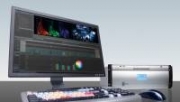DVS supports digital cinema at International Film Festival Rotterdam

More than 4000 minutes of tape-based submissions arriving in a variety of formats for the well-known International Film Festival Rotterdam (IFFR) were ingested, stored, DCP-encoded and validated by using the DVS’ VENICE, SpycerBox and CLIPSTER systems.
Given the tight time frame of the IFFR opening, the Dutch service providers Nedcipro and Filmtechniek handled this enormous workload by applying the DVS equipment in a unique and highly parallelized workflow. The IFFR was only able to present all submissions as digital cinema packages in high-quality with maximum security at the participating screens thanks to the flexibility, high-performance and 24/7 operation of the DVS systems.
The 41st IFFR again captivated the film movie world. The IFFR grew to become one of the largest audience- and industry-driven film festivals in the world, counting roughly 274,000 visitors in 2012. It focuses on presenting innovative, feature-length and short films by talented newcomers and established auteurs, as well as presenting cutting-edge media art.
With the transition to digital cinema well under way, all screens of the festival were equipped with digital projection systems for the first time. The festival organizers decided to reduce the stack of different tape players in each booth and to transfer short films and competition films, mostly delivered on all kinds of tape formats or even DVD video, to digital cinema packages. This made it necessary to digitize more than 4000 minutes of film material quickly right before the film festival’s start.
Digital filmlab service provider Nedcipro fulfilled this task with the help of several DVS systems on spot: two CLIPSTER DI workstations, one SpycerBox Flex flexible storage solution and one VENICE video server were in around-the-clock operation to prepare all movies for the festival opening in Rotterdam. VENICE guaranteed the seamless ingest of the video material directly into the SpycerBox Flex. Being configured as a SAN, the SpycerBox Flex allowed editing as well as storing the material.
The two CLIPSTER DI workstations provided a double advantage: They were used to capture material from tape to create the digital source master. The DI workstations also ensured the fast and efficient creation of high-quality DCPs from submitted material faster than real-time. Thanks to the new DCI Quality Control Tool, Nedcipro could effortlessly control the quality of the DCPs.
The professional video industry's #1 source for news, trends and product and tech information. Sign up below.
